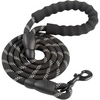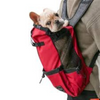Dogs are wonderful pets that bring great joy and companionship to many homes. However, it is essential to recognize that aggressive behavior in dogs can represent a serious problem, both for the dog itself and for the safety of those around it.
In this article, we'll look at how to identify signs of aggressive behaviors in dogs and discuss steps dog owners can take to proactively prevent and manage these behaviors.
Identify the signs of aggressive behavior in dogs :
- Growling or baring teeth : One of the most obvious signs of aggression in a dog is growling or baring teeth. This can happen when a dog feels threatened or uncomfortable.
- Biting : Biting is an obvious aggressive behavior. Bites can range in severity, from minor scratches to serious injuries.
- Harden the body : An aggressive dog may tense its body, raise its tail, raise its back hair and freeze in an attack position.
- Avoiding eye contact : Some dogs avoid eye contact when aggressive, while others stare intently at their target.
- Showing signs of nervousness or fear : Paradoxically, some aggressive dogs may show signs of nervousness or fear, such as licking their lips, avoiding contact, or hiding.
- Guarding Resources : Aggressive dogs may guard their resources, such as their food, toys, or space.
- Territorial Aggression : Some dogs become aggressive when defending their territory, such as their house or yard.
The causes
Aggressive behaviors in dogs can be caused by a variety of factors. Here are some of the common causes:
- Fear or anxiety : Dogs can become aggressive when they feel threatened or anxious. Fear can be triggered by social situations, unfamiliar environments, or past traumatic experiences.
- Physical Pain or Discomfort : Dogs experiencing pain or physical discomfort may respond with aggression. This can result from health problems, injuries or illnesses.
- Resource Guarding : Dogs may become aggressive to protect their food, toys, or space.
- Lack of socialization : Puppies who have not been properly socialized with other dogs, other animals and people may develop aggressive behaviors out of fear or distrust.
- Learned behavior : Dogs can learn aggressive behaviors through imitation of other aggressive dogs or through positive reinforcement of aggressive behaviors.
Preventing aggressive behavior
- Early socialization : Early socialization is essential to getting a dog used to different situations, people and animals. The earlier you start socializing your puppy, the better.
- Positive Education : Use positive education methods to reinforce desirable behaviors and discourage aggressive behaviors. Reward good behavior with treats, praise and affection.
- Consult a professional : If you notice signs of aggression in your dog, consult a dog behavior professional. They can assess the situation and develop a suitable treatment plan.
- Spaying/neutering : Spaying or neutering can reduce some aggressive behaviors related to sexual dominance, but it is not a 100% guarantee.
- Avoid stressful situations : If you know that your dog reacts aggressively in certain situations, avoid them as much as possible. For example, if your dog is aggressive toward other dogs, keep him on a leash and maintain a safe distance when meeting.
- Exercise and Mental Stimulation : Make sure your dog gets enough physical exercise and mental stimulation. A well-exercised dog is less likely to develop aggressive behaviors due to boredom or pent-up energy.
- Routine and structure : Dogs like routine and structure. Establish a daily routine for your dog, including regular meal times, walks and playtime.
- Keep your dog on a leash : If you are unsure of how your dog will react to certain situations, keep him on a leash to avoid incidents.
Recognizing the Signs of Aggressive Behavior in Dogs
It is essential to recognize the signs of aggressive behavior in dogs and take preventative measures to minimize the risks. Socialization, positive training, professional consultation and understanding the underlying causes of aggression are key elements in maintaining a happy, safe and well-balanced dog.













































